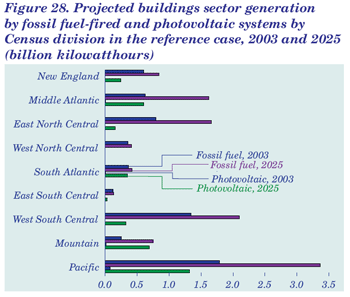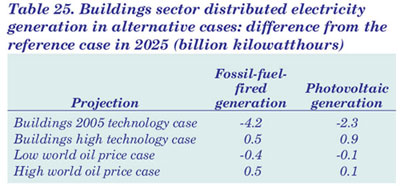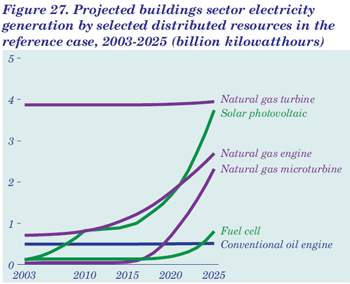Distributed Generation in Buildings
Supplement to the Annual Energy Outlook 2013 — Release date: August, 2013
Distributed generators installed by residential and commercial customers may supply electricity alone (generation) or electricity as well as heat or steam (CHP). On-site generators can have several advantages for electricity customers:
- If redundant capability is installed, reliability can be much higher than for grid-supplied electricity.
- Although electricity from distributed generation is generally more costly than grid-supplied power, the waste heat from on-site generation can be captured and used to offset energy requirements and costs for other end uses, such as space heating and water heating.
- Distributed generation can reduce the need for energy purchases during periods of peak demand, which can lower both current energy bills and, presumably, energy bills in future competitive markets, when peak prices will be set by the most expensive generator supplying power to the grid.
Currently, distributed generation provides a very small share of residential and commercial electricity requirements in the United States. The AEO2005 reference case projects a significant increase in electricity generation in the buildings sector, but distributed generation is expected to remain a small contributor to the sector’s energy needs. Although the advent of higher energy prices or more rapid improvement in technology could increase the use of distributed generation relative to the reference case projection, the vast majority of electricity used in buildings is projected to continue to be purchased from the grid.
The AEO2005 buildings models represent several grid-connected distributed generation technologies either as simple generation or as CHP, including conventional technologies such as oil or gas engines and combustion turbines and new technologies such as solar photovoltaics (PV), fuel cells, and microturbines. PV systems are the most costly of the distributed technologies for buildings on the basis of installed capital costs; however, once the systems are installed, no fuel costs are incurred. Petroleum-based generation is often used for emergency power backup in the commercial sector, but potential issues related to localized emissions make it less appropriate than natural-gas-based generation for continuous operation.
The projected adoption of distributed generation technologies in the buildings sector is based on forecasts of the economic returns from their purchase to meet baseload electricity needs (also thermal needs in the case of CHP) and on estimated participation in programs aimed at fostering distributed generation [112]. A detailed cash flow analysis is used to estimate the number of years needed to achieve a positive cumulative cash flow. The calculations include the annual costs (down payments, loan payments, maintenance costs, and fuel costs) and returns (tax deductions, tax credits, and energy cost savings) from the investment over a 30-year period from the time of the investment decision. The analysis includes the assumption that if more electricity is generated than needed, the excess can be sold to the grid [113].
Economic penetration of these technologies is a function of how quickly an investment in a technology is estimated to recoup its flow of costs. Program-related purchases are based on estimates from the Department of Energy’s Million Solar Roofs program, the Department of Defense fuel cell demonstration program, State RPS and other renewable energy programs and goals, and locally targeted initiatives, such as the Spire Solar Chicago program.
Table 24 shows projected installed capital costs [114] and electrical conversion efficiencies [115] for several of the distributed generation technologies represented in the buildings sector models. All fossil-fuel-fired systems are assumed to be used in CHP applications to take advantage of waste heat produced in the generation process. The costs and performance of fossil-fuel-fired CHP and PV systems are assumed to improve over time in the AEO2005 projections, with emerging technologies (fuel cells, microturbines, and PV) showing the most improvement. Technology learning is also expected to occur for the emerging technologies, allowing for additional cost declines if cumulative shipments increase sufficiently [116].
Market Factors
Ihe availability of technologies does not guarantee their widespread adoption. Many factors enter into the decision whether to purchase grid-supplied electricity to meet all of a building's power needs or to invest in a distributed generation system. Some of the issues that affect the market for distributed generation are discussed below.
Economics, Technology, and Suitability. In most instances, purchasing electricity is currently more economical for residential and commercial consumers than investing in distributed generation systems. On average, buildings sector sites are much smaller than industrial sites, and they are limited to technologies that have been more expensive and less efficient than larger CHP. Commercial firms generally have fewer operating hours per year and lower load factors than industrial firms, limiting the annual hours of system operation in which the higher first costs can be recouped. In addition, few types of buildings applications involve the steady thermal requirements that maximize the efficiency and economics of CHP systems.
Recent increases in fuel prices have further dampened enthusiasm for new CHP systems in buildings. Although fuel costs are not an issue with PV systems, their high installed capital cost limits economic viability to areas with high electricity prices and/or program-based incentives that offset a significant portion of the added investment costs. To the extent that deregulated retail electricity markets may pass along hourly or seasonal variation in the cost of producing electricity, such as time-of-day or real-time pricing, distributed generation applications may see further economic opportunities to offset higher energy costs; however, the adoption of such rate structures on a widespread basis in the residential and commercial sectors is currently highly uncertain.
All the fossil-fuel-fired distributed generation technologies represented in the reference case are assumed to be CHP systems; however, based on a January 2000 report prepared by ONSITE SYCOM Energy Corporation, only about 5 percent of existing commercial buildings in the United States have technically adequate electric demand and thermal loads to meet the criteria for CHP [117]. Considering the possibility of cost-effective CHP systems in smaller sizes and the advent of systems that include heat-activated cooling [118] increases the potential market for CHP adoption, but conditions would need to change from those represented in the reference case to encompass a much larger share of the commercial sector, let alone to make CHP systems economically attractive to meet residential consumers' everyday power and heating needs.
The amount of electricity a PV system can produce depends on the quality of the solar resource, as well as the size and efficiency of the system. On an annual basis, a PV system in Alaska would, in general, produce less electricity than an identical system in Arizona. The suitability of PV also depends on the ability to site the system to take advantage of the sunlight available. In addition, although PV systems tend to generate power during some of the peak electricity demand hours, their value in offsetting peak power costs may be somewhat less than that of fossil-fueled systems, because their output cannot be controlled with sufficient precision to follow real-time pricing signals or match a time-of-day tariff structure.
Regulation. Another factor to be considered when an investment in distributed generation technology is being made is the regulatory environment. Requirements for permits and approvals for distributed generation systems vary widely by State, technology, fuel, and project size. Researching and responding to a wide range of requirements is a hurdle for project development, adding expense to an already capital-intensive endeavor. Requirements can range from emissions and siting regulations to local building, zoning, and fire codes to local utility interconnection policies, exit fees, and standby rates [119].
Interconnection. The electric grid was not designed for two-way energy flow or storing energy at the distribution level. Consequently, utilities have implemented interconnection policies for the safe and reliable operation of the local grid when distributed generation units are interconnected to it. Some States are proposing to follow the requirements recently set forth by the Institute of Electrical and Electronics Engineers in IEEE 1547, "Standard for Distributed Resource Interconnects with Electric Power Systems" [120]. Others are developing their own interconnection standards. Still others have no standards, and procedures in those States are defined by individual electric utilities. Although some utilities have simplified the processes for small distributed generation projects (below 30 to 40 kilowatts), utilities generally require an interconnection study to be completed as part of the planning process for an installation.
Emissions. Restrictions may also be imposed on emissions from fossil-fuel-fired on-site generation that could contribute to smog and acid rain. Basic permitting and emission control requirements vary by State and whether a site falls within an emissions nonattainment zone with significant air quality problems [121]. Most States do not require permits for small units or units with small amounts of emissions. The threshold for such exemptions varies by State. In addition, distributed generation equipment that requires a permit is likely to require some emission limitations or controls. Systems that use fuel oil typically have higher "fuel-based" emissions than those that run on natural gas, making permitting and control costs a larger issue for those systems.
Reference Case Projections
The AEO2005 reference case includes residential and commercial distributed generation projections at the national level and for the nine Census divisions [122], using the assumptions and methodology described above. At the national level, there is currently little residential capacity for electricity generation from fossil fuels. Existing capacity consists primarily of emergency backup generators to provide electricity for minimum basic needs in the event of power outages. Generating capacity in the commercial sector is also primarily for emergency backup; however, some electricity supply and peak generation is reported. EIA's 1999 Commercial Buildings Energy Consumption Survey (CBECS) estimated that about 0.7 percent of all commercial buildings (1.6 percent of all commercial floorspace) use generators for purposes other than emergency backup.
Fossil-fuel-fired commercial generating facilities larger than 1 megawatt reported generating 7.0 billion kilowatthours of electricity in 2002 and 6.3 billion kilowatthours in 2003, about 0.5 percent of the sector's electricity needs [123]. The reference case projects an 80-percent increase in electricity supplied annually by fossil-fuel-fired distributed generation in the buildings sector, to 11.3 billion kilowatthours in 2025, but distributed generation still is expected to meet less than 1 percent of the electricity requirements for buildings nationally.Generation from natural gas turbines at commercial facilities is projected to remain essentially constant throughout the forecast. Gas turbines are viewed as a "mature" technology that is expected to show only modest improvement over the forecast, and, in addition, few commercial facilities have power and thermal needs or operating hours that would warrant investment in a large CHP system such as a gas turbine. Although engines are expected to remain a popular choice for commercial CHP, the adoption of microturbines and fuel cells is projected to increase later in the forecast period, reflecting projected cost declines and technological progress for these emerging technologies. With reference case electricity and fossil fuel prices, the vast majority of residential consumers are not expected to purchase fossil-fuel-fired distributed generation systems to meet their daily electricity requirements.
 The reference case projections for grid-connected PV incorporate current national incentives for commercial sector systems, including an Investment Energy Tax Credit and favorable depreciation treatment [124]. The effects of regional and local incentives are estimated through projections for program-related purchases of PV systems. Although AEO2005 projections are limited to grid-connected systems, EIA estimates that remote PV applications (off-grid power systems) representing as much as 134 megawatts of electricity generation capacity were in service in 2002, in addition to another 362 megawatts of PV generating capacity in specialized applications, such as communications and transportation [125].
The reference case projections for grid-connected PV incorporate current national incentives for commercial sector systems, including an Investment Energy Tax Credit and favorable depreciation treatment [124]. The effects of regional and local incentives are estimated through projections for program-related purchases of PV systems. Although AEO2005 projections are limited to grid-connected systems, EIA estimates that remote PV applications (off-grid power systems) representing as much as 134 megawatts of electricity generation capacity were in service in 2002, in addition to another 362 megawatts of PV generating capacity in specialized applications, such as communications and transportation [125].
In the reference case, electricity generation from PV systems in the buildings sector is projected to increase at an average annual rate of 17 percent, to 3.7 billion kilowatthours in 2025 (Figure 27). New installations through 2010 are expected to result from program-related purchases that generally include incentives to help defray the high capital costs associated with the technology. Later in the forecast, as a result of projected cost declines combined with favorable tax treatment, PV systems are projected to become economically attractive without additional subsidies in regions where electricity costs are relatively high.
Delivered energy prices vary by geographical region in the United States and are expected to continue to differ by region throughout the forecast horizon. Variations in electricity prices, fossil fuel prices, and the relative difference between electricity and fossil fuel prices result in significant differences in the projected adoption of distributed generation technologies by region. Public policies and incentive programs differ by State and region as well, adding to the expected regional variation in distributed generation.
The use of fossil-fuel-fired distributed generation technologies in CHP applications is projected to grow fastest in regions with high electricity prices and relatively moderate natural gas prices (Figure 28). Although the Mountain Census division is projected to show the fastest rate of growth in the reference case, 5.0 percent per year between 2003 and 2025, the Pacific Census division is projected to show the greatest increase in generation, 1.6 billion kilowatthours. Census divisions with relatively low electricity prices, such as the East South Central division, show little growth.
Near-term adoption of PV systems in the buildings sector is expected to be concentrated in regions that exhibit some combination of the following: active programs to foster the development of PV, high electricity rates, and sufficient periods of sunlight to maintain PV electricity production. For example, in addition to abundant sunshine in many parts of California, the California Energy Commission's rebate program, funded by a System Benefits Charge, refunds up to one-half of the installed cost of PV systems. States with RPS programs that require a percentage of electricity generation to be provided from renewable energy sources often offer "extra credit" for PV that increases its attractiveness [126]. The Pacific Census division, the current leader in PV electricity generation, is expected to show the greatest increase in the AEO2005 reference case, with projected PV generation of more than 1 billion kilowatthours in 2025 (Figure 28). In the New England and Middle Atlantic Census divisions, where high electricity prices are projected, the use of distributed PV systems is projected to increase by more than 20 percent from 2003 to 2025.
Alternative Cases
 |
Technology Improvement. The buildings sector 2005 technology and high technology cases included in AEO2005 examine the sensitivity of the projections to different technology assumptions in combination with reference case energy prices and economic assumptions [127]. These cases alter residential and commercial assumptions for distributed generation technologies, end-use equipment, and building shell measures, focusing only on technological progress in the buildings sector. In the 2005 technology case, which assumes no further technological improvements, fossil-fuel-fired CHP is projected to total 7.2 billion kilowatthours in 2025, a 14-percent increase from 2003 but 37 percent (4.2 billion kilowatthours) lower than the reference case projection (Table 25). Similarly, PV generation is projected to total 1.4 billion kilowatthours in 2025, 62 percent (2.3 billion kilowatthours) lower than reference case projection.
The buildings high technology case is based on more optimistic assumptions for emerging distributed generation technologies, allowing greater cost declines as shipments increase [128]. The high technology assumptions result in projected generation of 11.8 billion kilowatthours from fossil-fuel-fired CHP in 2025, 4 percent higher than the reference case projection. PV generation is projected to total 4.7 billion kilowatthours in 2025 in the high technology case, 25 percent higher that the reference case projection.
Energy Prices. In the AEO2005 low world oil price case, lower prices for petroleum lead to lower projected electricity prices. As a result, more consumers are expected to purchase electricity rather than invest in distributed generation systems. In the low world oil price case, generation from fossil-fuel-fired CHP in buildings is projected to total 10.9 billion kilowatthours in 2025 (400 million kilowatthours less than in the reference case), and PV generation is projected to total 3.6 billion kilowatthours (100 million kilowatthours less than in the reference case)—both 4 percent lower than the corresponding reference case projections (Table 25). In the high world oil price case, projected electricity and natural gas prices are slightly higher than in the reference case for most of the forecast period. As a result, in 2025, generation from fossil-fuel-fired CHP in buildings is projected to total 11.8 billion kilowatthours, 4 percent (500 million kilowatthours) higher than the reference case projection, and PV generation is projected to total 3.9 billion kilowatthours, 4 percent (100 million kilowatthours) more than in the reference case.
Footnote
1 Section 112 of the Clean Air Act Toxic Standards (MATS). Compliance with MATS is expected to require all coal plants to add emission control equipment, such as flue gas desulfurization and dry sorbent injection by 2016, or to be retired.


